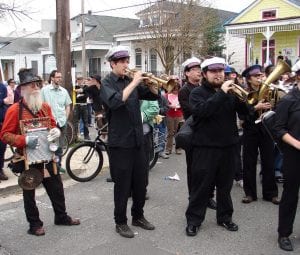New Orleans Jazz Funeral Service Rituals
The tradition of the New Orleans jazz funeral has fallen away somewhat in the wake of Hurricane Katrina but has not been forgotten. Although the wild music and dancing have, historically, flown in the face of prevailing sentiments about the required solemnity of the traditional memorial service, the New Orleans jazz funeral grew throughout the 20th century to achieve its own respected standing among the many ways to commemorate the passage of a loved one.
The music and dancing of the jazz funeral were intended to both help the deceased find their way to heaven and to celebrate the final release from the bounds of earthly life, which had, in the past, included the release from slavery. The call-and-response style of music and chant, coupled with tambourines, drums, music, and dancing were elements of African funeral ceremonies which crossed the seas with captive slaves. In American culture, this type of funeral caught on among the African- American population of the deep south, but, as the tradition was not welcomed by the Catholic church, was restricted largely to the black Protestants of New Orleans and came to be the funeral of choice particularly among impoverished people and musicians.
Towards the middle of the 20th century, as the movement caught on more, social clubs and insurance policies arose to help the underprivileged afford these funerals, giving rise to the most celebrated of funerary jazz bands, the Dirty Dozen Brass Band. Over time, the jazz funeral tradition grew to become New Orleans’ most honored of funeral ceremonies, with horse-drawn hearses and parades for fallen police officers, well-known musicians and other pillars of the community. In its final days, the traditional hymns, gospel, rock and r&b music of the jazz funeral began to fuse with influences from the funk and hip-hop world as street gangs and rappers adopted this style for honoring their dead. One of the last jazz funerals, that of rapper James “Soulja Slim” Tapp, drew a crowd of thousands.
Video of the Second Line for Allen Toussaint, the influential New Orleans musician, songwriter and producer, at the New Orleans Jazz Fest on April 23, 2016.
Historically, the New Orleans jazz funeral could last up to a week and sometimes even included a parade. A typical funeral began with a slow march from the home of the deceased to the church or funeral home. During the march, the coffin may have been carried by a horse-drawn hearse and was accompanied by a brass band playing somber dirges and hymns. After the memorial service, the march would proceed to the cemetery and the tone would remain somber until the coffin had been placed in the ground or until the group was out of sight of the church. People on the streets where the march passed were welcome to join in and go along with the mourners to the cemetery. This group was referred to as the “second line.“ The brass band would play a couple more hymns, though these were played with a swing beat, to alert mourners that the mood was about to change, then they would launch into wilder music with tambourines and drums. The music and dancing were both a cathartic release for mourners and a celebration of a life well lived. In this state of jubilation, the group would then march back to the location of their reception.
Perhaps the jazz funeral of the highest honor was held on August 29, 2006, in memory of the 1,700 victims of Hurricane Katrina in Mississippi and Louisiana. The memorial was held at the Ernest N. Morial Convention Center, where thousands were stranded without food or water just one year earlier. Led by Mayor Ray Nagin and Lt. Gen. Russel Honoré, the procession included a horse-drawn hearse carrying an empty coffin, a brass band, fire trucks and the National Guard. There was a moment of silence in the small community where the hurricane first made landfall, tolling bells at 9:38 a.m. to commemorate the breach of the first levee and an interfaith prayer service. Many residents found the ceremony to be a beautiful and tasteful way to remember their many losses. Today, New Orleans has made great strides in restoring its native culture.
Carrying vestiges of African funeral rituals and originally intended to celebrate the new-found freedom of a departed slave, the jazz funerals of New Orleans evolved throughout the 20th century to come to be recognized as one of the most respected ways to exalt the life of a loved one. Musicians, police officers and African-Americans, in particular, have been remembered by this style of funeral and finally, those many victims of Hurricane Katrina were paid high tribute as well, New Orleans style. A symbol of life, a symbol of death and a symbol of rebirth, the New Orleans jazz funeral salutes a life well lived and the passage of a departed soul into a better world.


